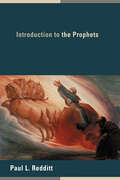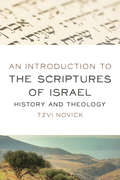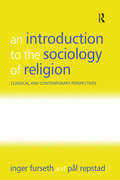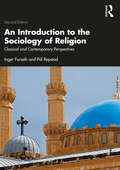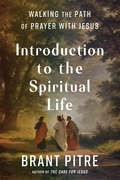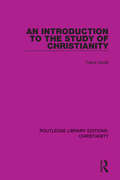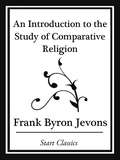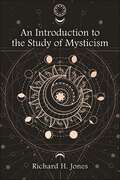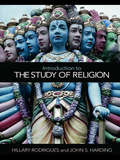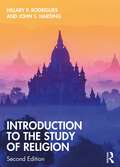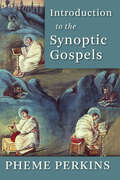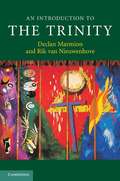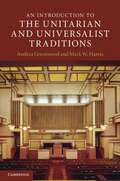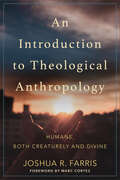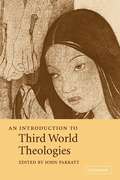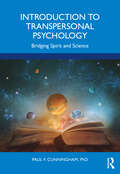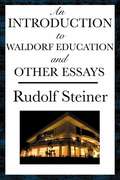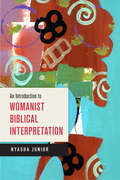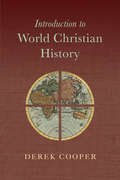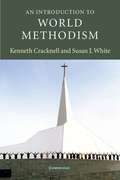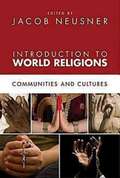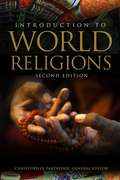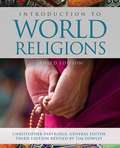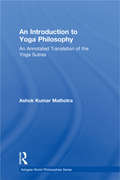- Table View
- List View
Introduction to the Prophets
by Paul L. ReddittWriting in a conversational rather than a scholarly tone, Paul Redditt assumes little or no prior knowledge of the Old Testament as he presents and introduces the Major and Minor Prophets in the canonical order of the English Bible. The chapters of Redditt's Introduction to the Prophets discuss the place of each book in the canon; the literary setting of each book; their structure, integrity, and authorship; the main genre(s) in each; special features of each book; basic emphases of each book; and problems -- theological, literary, or historical -- raised by a study of the book. Among other things, Redditt demonstrates that the prophets were both &“foretellers&” and &“forthtellers,&” and he argues that the Old Testament prophets developed the concept of monotheism. Each chapter ends with questions for further reflection. Concluding the volume are a helpful glossary and several indexes.
An Introduction to the Scriptures of Israel: History and Theology
by Tzvi NovickIn this distinctive textbook for Hebrew Bible courses, author Tzvi Novick&’s approach is thematic rather than chronological. Sorting the books according to their historical context, theological claims, and literary conventions, Novick examines and elucidates the historical and intellectual development of the Hebrew Bible. With attentiveness to both historical-critical and traditional-canonical approaches, An Introduction to the Scriptures of Israel focuses on the dichotomy of the particular and the universal. It shows how this dichotomy impacts each book&’s style and content and how it informs the development of Jewish and Christian traditions. This nontraditional textbook is coherent, engaging, and succinct—a perfect resource for any introductory Hebrew Bible course.ContentsPreface Abbreviations 1. Three Introductions 2. The Wisdom Tradition: Religion without Revelation 3. Revelation and Love: The Patriarchal Narratives and the Song of Songs 4. Joseph and Narrative 5. The Exodus: Freedom and Sonship 6. Sinai: Covenant and Code 7. The Problem of Monarchy: Samuel and Kings 8. Condemning Israel, Sparing the Nations: Amos and Jonah 9. Eden and the Art of Reading 10. Priestly Theology and Holy Space 11. Exile and Return: Prophetic Visions 12. The Consolidation of Judaism: Temple and Torah 13. Violence and Identity: Joshua and Judges 14. Jews, Gentiles, and Gender: Esther, Ruth, Ezra, and Nehemiah 15. Apocalyptic: Daniel and the Dead Sea Scrolls 16. The Israelite at Prayer: The Book of PsalmsSubject Index Scripture and Other Ancient Sources Index
An Introduction to the Scriptures of Israel: History and Theology
by Tzvi NovickIn this distinctive textbook for Hebrew Bible courses, author Tzvi Novick&’s approach is thematic rather than chronological. Sorting the books according to their historical context, theological claims, and literary conventions, Novick examines and elucidates the historical and intellectual development of the Hebrew Bible. With attentiveness to both historical-critical and traditional-canonical approaches, An Introduction to the Scriptures of Israel focuses on the dichotomy of the particular and the universal. It shows how this dichotomy impacts each book&’s style and content and how it informs the development of Jewish and Christian traditions. This nontraditional textbook is coherent, engaging, and succinct—a perfect resource for any introductory Hebrew Bible course.ContentsPreface Abbreviations 1. Three Introductions 2. The Wisdom Tradition: Religion without Revelation 3. Revelation and Love: The Patriarchal Narratives and the Song of Songs 4. Joseph and Narrative 5. The Exodus: Freedom and Sonship 6. Sinai: Covenant and Code 7. The Problem of Monarchy: Samuel and Kings 8. Condemning Israel, Sparing the Nations: Amos and Jonah 9. Eden and the Art of Reading 10. Priestly Theology and Holy Space 11. Exile and Return: Prophetic Visions 12. The Consolidation of Judaism: Temple and Torah 13. Violence and Identity: Joshua and Judges 14. Jews, Gentiles, and Gender: Esther, Ruth, Ezra, and Nehemiah 15. Apocalyptic: Daniel and the Dead Sea Scrolls 16. The Israelite at Prayer: The Book of PsalmsSubject Index Scripture and Other Ancient Sources Index
An Introduction to the Sociology of Religion: Classical and Contemporary Perspectives
by Inger Furseth Pål RepstadIs it true that religion is weakening in modern times, or are we facing religious resurgence? What is fundamentalism? How does it emerge and grow? What role does religion play in ethnic and national conflicts? Is religion a fundamental driving force or do political leaders use religion for their own purposes? Do all religions oppress women? These are some of the questions addressed in this book. An Introduction to the Sociology of Religion provides an overview of sociological theories of contemporary religious life. Some chapters are organized according to topic. Others offer brief presentations of classical and contemporary sociologists from Karl Marx to Zygmunt Bauman and their perspectives on social life, including religion. Throughout the book, illustrations and examples are taken from several religious traditions.
An Introduction to the Sociology of Religion: Classical and Contemporary Perspectives
by Inger Furseth Pål RepstadWhat are religion and nonreligion? How do fundamentalism and religious radicalization emerge and grow? How do social class, gender, sexuality, race, ethnicity, and other factors affect religious beliefs, practices, and organizations? Is religion a fundamental driving force or do political leaders use religion for their own purposes? In exploring these pertinent questions, An Introduction to the Sociology of Religion provides an overview of sociological theories of contemporary religious life. Theoretical discussion is accompanied by presentations of empirical research from several religious traditions in many parts of the world. The sociology of religion is linked closely to developments in general sociology. Some chapters are organized according to topic, while others offer brief presentations of classical and contemporary sociologists from Karl Marx to Patricia Hill Collins and their perspectives on social life, including on religion. This second edition has been thoroughly updated throughout with new chapters on religion and social inequalities, social and religious movements, and extremism. Covering classical sociology of religion as well as contemporary debates and topics, this book is ideal reading for students approaching the sociology of religion for the first time.
Introduction to the Spiritual Life: Walking the Path of Prayer with Jesus
by Brant PitreA compelling exploration of the biblical foundations, contemplative practices, and spiritual path of Jesus himself—from the bestselling author of The Case for Jesus&“What happens when a biblical theologian explores classic spirituality? This book. Pitre&’s students have asked, Why have we never heard this before? The reader wonders the same.&”—Dr. David Fagerberg, author of Liturgical Mysticism The path of following Jesus is an ancient and storied spiritual tradition. Yet many believers are not familiar with the three major forms of prayer and the three stages of spiritual growth that exist to bring them closer to God.In his most personal book yet, Dr. Brant Pitre draws on the riches of the Bible, the words of Jesus, and the writings of mystics across the centuries to shed light on the mystery—and wonder—of the spiritual life.Starting with the age-old belief that the path of prayer is not only informative but transformative, Dr. Pitre explores• the scriptural roots of vocal, meditative, and contemplative prayer• the purgative, illuminative, and unitive stages of spiritual growth• the spiritual exercises of prayer, fasting, and almsgiving• the Jewish roots of the Lord&’s Prayer• Lectio Divina: how to pray with the Bible• seven vices and their seven opposing virtues• the battle of prayer: how to deal with difficulty and distractions• the &“dark night of the soul&” in the ScripturesFull of sacred truths, contemplative insights, and practical steps, Introduction to the Spiritual Life is a veritable biblical road map of the spiritual landscape that enables us to follow Jesus as our primary guide.
An Introduction to the Study of Christianity
by Frank DoddOriginally published in 1938, An Introduction to the Study of Christianity is a consideration of what is truly essential in the Christian faith. The book provides a detailed survey of key elements relating to the origin and growth of Christianity, and puts forward the argument that any apparent blemishes or mistakes are the result of human imperfection and misunderstanding of the real teaching of Jesus and his immediate followers, rather than of any shortcomings in the teaching itself. It first sets out the foundations of Christianity and then calls attention to the different interpretations that successive generations of Christians have placed on them. Exploring the history of the Christian faith up to the 1930s, An Introduction to the Study of Christianity will appeal to those with an interest in the history of religion, Christianity, theology, and religious studies.
An Introduction to the Study of Comparative Religion (Start Classics)
by Frank Byron JevonsThe Hartford-Lamson Lectures on The Religions of the World are delivered at Hartford Theological Seminary in connection with the Lamson Fund, which was established by a group of friends in honor of the late Charles M.Lamson, D.D., sometime President of the American Board of Commissioners for Foreign Missions, to assist in preparing students for the foreign missionary field. The Lectures are designed primarily to give to such students a good knowledge of the religious history, beliefs, and customs of the peoples among whom they expect to labor. As they are delivered by scholars of the first rank, who are authorities in their respective fields, it is expected that in pubUshed form they will prove to be of value to students generally.
An Introduction to the Study of Mysticism
by Richard H. Jones2022 CHOICE Outstanding Academic TitleThe purpose of this book is to fill a gap in contemporary mystical studies: an overview of the basic ways to approach mystical experiences and mysticism. It discusses the problem of definitions of “mystical experiences” and “mysticism” and advances characterizations of “mystical experiences” in terms of certain altered states of consciousness and “mysticism” in terms of encompassing ways of life centered on such experiences and states. Types of mystical experiences, enlightened states, paths, and doctrines are discussed, as is the relation of mystical experiences and mysticism to religions and cultures. The approaches of constructivism, contextualism, essentialism, and perennialism are presented. Themes in the history of the world’s major mystical traditions are set forth. Approaches to mystical phenomena in sociology, psychology, gender studies, and neuroscience are introduced. Basic philosophical issues related to whether mystical experiences are veridical and mystical claims valid, mystics’ problems of language, art, and morality are laid out. Older and newer comparative approaches in religious studies and in Christian theology are discussed, along with postmodernist objections. The intended audience is undergraduates and the general public interested in the general issues related to mysticism.
Introduction to the Study of Religion
by Hillary P. Rodrigues John S. HardingWhy do people study religion? How have they studied it in the past? How do we study religion today? Is the academic study of religion the same as religious education? These and many other questions are addressed in this engaging introduction to the discipline of religious studies, written by two experienced university teachers. The authors have crafted this book to familiarize novice students with key concepts and terminology in the study of religion. More advanced students will find a varied array of theoretical perspectives and methodological approaches to the field. Topics include: definitions of religion perspectives in the study and teaching of religion how religion began to be studied: traditional perspectives – philosophical and theological how people experience religion: perspectives in the study of religious consciousness and perception – phenomenological and psychological studying religion within communities: Social and cultural perspectives – anthropological, sociological, political and economic judging religion: critical perspectives –feminist approaches, the interaction of popular literature and religion contextual perspectives – historical and comparative. The book encourages students to think critically about the theories and methods presented. Students will find arguments for the strengths and limitations of these approaches, understand connections among religious studies and other intellectual movements, and develop their own ideas of how they might want to go about the study of religion. Summary boxes, a timeline, a glossary and other pedagogic aids help students grasp key concepts, along with a companion website at www.sastor.com.
Introduction to the Study of Religion
by Hillary P. Rodrigues John S. HardingWhy do people study religion? How have they studied it in the past? How do we study religion today? Is the academic study of religion the same as religious education? These and many other questions are addressed in this engaging introduction to the discipline of religious studies. Topics include Definitions of religion Perspectives in the study and teaching of religion How religion began to be studied: Traditional perspectives—philosophical and theological How people experience religion: Perspectives in the study of religious consciousness and perception—phenomenological and psychological Studying religion within communities: Social and cultural perspectives—anthropological, sociological, political, and economic Judging religion: Critical perspectives—feminist approaches, the interaction of popular literature and religion Contextual perspectives—historical and comparative Themes, theories, and current directions The thoroughly updated second edition encourages students to think critically about the theories and methods presented. Students will find arguments for the strengths and limitations of these approaches, understand connections among religious studies and other intellectual movements, and develop their own ideas of how they might want to go about the study of religion. Summary boxes, discussion questions, a glossary, a chronology of key figures and texts, and other pedagogic aids help students grasp key concepts.
Introduction to the Synoptic Gospels
by Pheme PerkinsIn this book respected New Testament scholar Pheme Perkins delivers a clear, fresh, informed introduction to the earliest written accounts of Jesus — Matthew, Mark, and Luke — situating those canonical Gospels within the wider world of oral storytelling and literary production of the first and second centuries. Cutting through the media confusion over new Gospel finds, Perkins’s Introduction to the Synoptic Gospels presents a balanced, responsible look at how the Gospels of Matthew, Mark, and Luke came to be and what they mean.
An Introduction to the Trinity
by Rik Van Nieuwenhove Declan MarmionOver the last decade there has been a resurgence of writing on the Trinity, indicating a renewal of ideas and debate concerning this key element of Christian theology. This introduction challenges the standard account of a decline and revival in Trinitarian theology, taking into account recent, alternative readings of the theological tradition by Lewis Ayres and Michel Barnes amongst other scholars. By clearly analysing the scope of these new approaches, the authors establish the importance of a considered understanding of the Trinity, resisting the notion of separating faith and reason and identifying theology's link to spirituality. Their account also eschews the easy stereotypes of Western Christianity's supposedly more Unitarian approach as opposed to the more Trinitarian view of the East. Offering an overview of the main people and themes in Trinitarian theology past and present, this book thus provides an accessible, comprehensive guide for students and scholars alike.
An Introduction to the Unitarian and Universalist Traditions
by Andrea Greenwood Mark W. HarrisHow is a free faith expressed, organised and governed? How are diverse spiritualities and theologies made compatible? What might a religion based in reason and democracy offer today's world? This book will help the reader to understand the contemporary liberal religion of Unitarian Universalism in a historical and global context. Andrea Greenwood and Mark W. Harris challenge the view that the Unitarianism of New England is indigenous and the point from which the religion spread. Relationships between Polish radicals and the English Dissenters existed and the English radicals profoundly influenced the Unitarianism of the nascent United States. Greenwood and Harris also explore the US identity as Unitarian Universalist since a 1961 merger and its current relationship to international congregations, particularly in the context of twentieth-century expansion into Asia.
Introduction to Theological Anthropology: Humans, Both Creaturely and Divine
by Joshua R. FarrisWritten from an evangelical perspective, this comprehensive introduction explores some of the most important issues in theological anthropology.
An Introduction to Third World Theologies
by John ParrattProviding the first overview of the main trends and contributions to Christian thought of Third World theologies, this book gathers essays from experts on Latin America, India, East Asia, West and East Africa, Southern Africa and the Caribbean. It analyzes the common context of the Third World theologies in their experience of colonialism and Western missions, and suggests that they provide different perspectives on what it means to be a Christian in today's world.
Introduction to Transpersonal Psychology: Bridging Spirit and Science
by Paul F. Cunningham, Ph.D.Introduction to Transpersonal Psychology: Bridging Spirit and Science provides an accessible and engaging introduction to this complex and evolving field. Adopting a modular approach, the book systematically relates key themes of Transpersonal Psychology to three major areas within psychology: general psychology, experimental psychology, and clinical psychology. Covering a wide range of topics including transpersonal states of consciousness, biological foundations, research methods, and cognition, the book also features extensive discussion of transpersonal theorists and the impact of their work on our understanding of psychological concepts. The book also introduces contemporary developments in the field and anticipates future advances such as feminist perspectives and cross-cultural approaches alongside practical experiments designed to give transpersonal theories and concepts psychological roots. A critical evaluation of both mainstream and transpersonal theories and research is applied throughout to foster analytical skills and encourage critical and scientific thinking about humanity’s nature as spiritual creatures and ways to educate for personal and social transformation. Accompanied by an online instructor’s manual, this book will be an essential companion for all students of Transpersonal or Humanistic Psychology, or those interested in applying transpersonal ideas to mainstream psychological research.
An Introduction to Waldorf Education and Other Essays
by Rudolf SteinerCollected here are fourteen essays by Rudolf Steiner covering subjects such as Waldorf Education, The Reordering of Society, The Human Soul, Karma, and Knowledge. These essays are informative and lively. Rudolf Steiner was an Austrian philosopher, literary scholar, educator, artist, playwright, social thinker, and esotericist. His contributions to society were immense.
An Introduction to Womanist Biblical Interpretation
by Nyasha JuniorAn Introduction to Womanist Biblical Interpretation provides a much-needed introduction to womanist approaches to biblical interpretation. It argues that womanist biblical interpretation is not simply a byproduct of feminist biblical interpretation but part of a distinctive tradition of African American women's engagement with biblical texts. While womanist biblical interpretation is relatively new in the development of academic biblical studies, African American women are not newcomers to biblical interpretation. Written in an accessible style, this volume highlights the importance of both the Bible and race in the development of feminism and the emergence of womanism. It provides a history of feminist biblical interpretation and discusses the current state of womanist biblical interpretation as well as critical issues related to its development and future. Although some African American women identify themselves as "womanists," the term, its usage, its features, and its connection to feminism remain widely misunderstood. This excellent textbook is perfect for helping to introduce readers to the development and applications of womanist biblical interpretation.
Introduction to World Christian History
by Derek CooperChristianity is a global faith. Today, people are increasingly aware that Christianity extends far beyond Europe and North America, permeating the Eastern and Southern hemispheres. What we may know less well is that Christianity has always been a global faith. A vast untold story waits to be heard beyond the familiar tale of how the Christian faith spread across Europe. Not only was Jesus born in Asia, but in the early years of the church Christianity found fertile soil in Africa and soon extended to East Asia as well. In this brief introduction to world Christian history, Derek Cooper explores the development of Christianity across time and the continents. Guiding readers to places like Iraq, Ethiopia and India, Scandanavia, Brazil and Oceania, he reveals the fascinating—and often surprising—history of the church.
An Introduction to World Methodism
by Kenneth Cracknell Susan J. WhiteWith over 75 million currently practicing Methodists worldwide, this book treats Methodism as a global religious tradition, examining its rich diversity as well as the core beliefs and attitudes that all Methodists share. It serves as an introduction to the patterns of Methodist life, demonstrating how the religion has developed from British and American roots in different cultural contexts. In addition to the lasting traditions of John and Charles Wesley, An Introduction to Methodism reflects the on-going contribution of Methodism to the ecumenical movement and inter-religious relations. Its analysis includes abundant resources encouraging further study. Kenneth Cracknell is Professor of Theology and Global Studies at Brite Divinity School, Fort Worth, Texas. He has been a theological teacher in Nigeria, a Methodist pastor in Britain, and Director of Interfaith Relations for the British Council of Churches. He has also been a consultant to the World Council of Churches on interfaith issues since 1979 and has visited churches in all parts of the world. He is the author of Toward a New Relationship: Christians and People of Other Faith (Epworth Press, 1986) and Justice, Courtesy and Love: Theologians and Missionaries Encountering Other Religions 1846-1914 (Epworth, 1995). Susan J. White is Alberta H. and Harold L. Lunger Professor of Spiritual Resources and Disciplines at Brite Divinity School, Fort Worth, Texas. She has been a member of the Church of England Liturgical Commission, and the Joint Liturgical Group of Great Britain and Ireland, and consultant for liturgical revision to the Methodist Faith and Order Committee and the Office of Worship of the Board of Discipleship of the United Methodist Church. She is the author of Groundwork of Christian Worship (Epworth, 1997) The Spirit of Worship: The Liturgical Tradition (Orbis Books, 2000) and A History of Women in Christian Worship (Pilgrim Press, 2003)
Introduction to World Religions: Communities and Cultures
by Jacob NeusnerWith an emphaisis on communities of faith, this accessible book will introduce students to the classic texts, important events, key figures, defining rituals, essential creeds and symbols of world religions. Contents: Introduction by William Scott Green Judaism A. Judaism: Beginnings: Religion of Ancient Israel by Baruch A. Levine B. Judaism: The Formation by Jacob Neusner C. Judaism in Modern Times: Reform, Orthodox, and Conservative Judaism, Zionism by Jacob Neusner 2. Christianity A. Christianity: Beginnings by Bruce Chilton B. Christianity: Roman Catholicism by Lawrence S. Cunningham C. Orthodox Christianity by J. A. McGuckin D. Christianity: Protestantism by Martin E. Marty 3. Islam A. Islam: Beginnings by Th. Emil Homerin B. Islam: The Shiite Tradition by Liyakat Takim C. Islam: The Sunni Tradition by Th. Emil Homerin 4. Hinduism by Douglas Brooks 5. Buddhism A. Buddhism: Beginnings by Mario Poceski B. Buddhism: The Theravada Tradition by Kristen Scheible C. Buddhism: The Mahayana Tradition by Mark L. Blum 6. Daoism by Mark Meulenbled 7. Confucianism by Mark A. Csikszentmihalyi 8. Shinto by James L. Ford 9. Indigenous Religions A. Indigenous Religious Tradition by Jualynne E. Dodson and Soyna Maria Johnson B. African Indigenous Religions by Jacob Olupona 10. New 19th Century American Religions by Danny L. Jorgensen 11. New 20th Century American Religions by Dell deChant
Introduction To World Religions
by Christopher Partridge Tim DowleyA leading textbook for world religion, this new edition is designed to help students in their study and research of the world's religious traditions. Known and valued for its balanced approach and its respected board of consulting editors, this text addresses ways to study religion, provides broad coverage of diverse religions, and offers an arresting layout with rich illustrations. The second edition has new and extended primary source readings, a stronger section on the religions of South Asia, additional maps, a new full-color, student-friendly format, and more.
Introduction To World Religions
by Christopher Partridge Timothy DowleyThis leading textbook for world religion is designed to help students in their study and research of the world's religious traditions. Known and valued for its balanced approach and its respected board of consulting editors, this text addresses ways to study religion, provides broad coverage of diverse religions, and offers an arresting layout with rich illustrations. Introductory sections on understanding religion and the religions of antiquity lay the foundation for the study of the numerous religious traditions highlighted in the volume, including indigenous religions, Hinduism, Buddhism, Jainism, Judaism, Christianity, Islam, Sikhism, and Chinese, Korean, and Japanese religions. <p><p> The user-friendly content is enhanced by charts of religious festivals, historic timelines, updated maps of the world's religions, and a useful glossary. Both historical overviews and modern perspectives for each religion are included. This third edition has several updates, including a new design, a new section on women and religion, and a newly revised section on religions in today's world.
An Introduction to Yoga Philosophy: An Annotated Translation of the Yoga Sutras (Ashgate World Philosophies Series)
by Ashok Kumar MalhotraWith its promise of personal improvement, physical well-being and spiritual enrichment, yoga is enjoying a resurgence in popularity at the turn of the third millennium. To unravel the mystery of the discipline, its philosophies and relevance in contemporary life, the original text of the Yoga Sutras of Patanjali must be explored. This book offers the first accessible translation and commentary on Patanjali's Yoga Sutras. An introductory section examines the multidimensional aspects of yoga as philosophy, psychology, science, and religion, as well as exploring popular versions of yoga in the West. The core of the book offers a new translation of the entire text of the Yoga Sutras, in a language that is clear and comprehensible to students. Commentaries are presented to highlight the meaning of various statements (sutras) and key themes are outlined via sectional summaries. A full glossary of key words and names is also provided. Concluding chapters look at yoga in contemporary life, revealing the popularity of yoga in the 21st century through Star Wars, and exploring yoga's connection to health and science, contrasting yoga's holistic view of healing with that of the limited view of present day medical science. Sample physical, breathing and meditation exercises are provided. An Introduction to Yoga Philosophy offers a comprehensive introduction to the Yoga Sutras text of Patanjali to all students and interested readers of Indian philosophy and religion, world religions, east-west psychology, and mysticism.
